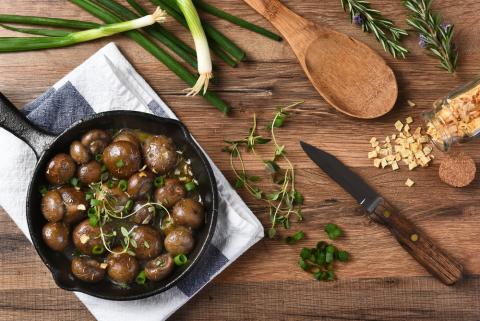
I teach classes on medicinal mushrooms and, invariably, there’s a student who doesn’t like to eat mushrooms despite their interest in mushrooms as medicine. I usually think “?!?!?!?!?!?!?!?!”, but don’t express that out loud. I love mushrooms. Embarrassingly enough, I even used to like the floppy, pallid, canned kind I grew up with.
For many folks, texture is the reason they say no to a mushroom meal. Mushrooms are rubbery if not cooked properly. There’s an easy fix: Dry sautéing! This browns the mushrooms, improves the texture, and brings out a rich, nutty flavor.
I learned the dry sautéing trick on a rainy herb school camp out north of San Francisco. We found a stream side tree festooned with oyster mushrooms and brought a bunch back to our campsite. Protected from the deluge by a tarp fixed amongst the surrounding trees, the chef among us taught us how to properly cook the oysters. It was one of the best mushroom meals I’ve ever had, though the verdant surroundings and the usual camp fare in comparison may have contributed to this. (By the way, folks maintain “oyster logs” in France; watering logs that sprout oyster mushrooms to encourage more frequent fruiting!)
Fresh mushrooms contain a lot of water (especially if you’ve just harvested them in a downpour!). Chopping up the bolete bounty you just brought home and piling them up in a pan to cook will result in chewy and slimy mushrooms. And the flavor won’t be anything to write home about. This is because the mushrooms get steamed as the water evaporates. Instead, dry sautéing the mushrooms in a single layer first to remove the water without steaming them will bring out their earthy, meaty flavor and they’ll be divine!
How to Dry Sauté Mushrooms
- Cut fresh mushrooms in thin, even slices.
- Pre-heat a pan on medium heat. Place a single layer of mushroom slices in the pan and sprinkle them with salt. Salt helps to draw out the water.
- Cook until the mushrooms start to shrink and brown, then scrape them to the side of the pan and add more slices, again, sprinkling them with salt.
- Repeat the process until all of the slices have been browned. If you have a lot of mushrooms to get through, you can remove the dry sautéed slices and add them back at the end.
- Add whatever you want for flavor and continue cooking (this is also a good time to add them to a pizza!):
- A fat to further brown and crisp the mushrooms (e.g., ghee, butter, olive oil, coconut oil,
- etc.)
- Chopped onions, shallots and/or garlic
- Herbs/spices such as pepper, garlic powder, rosemary, thyme or whatever you like
- Other flavorings (e.g., sherry, dry vermouth, wine)
- Sometimes it’s good to keep the additions simple to showcase the mushroom flavor—I’ll often add just ghee and black pepper!
Some mushrooms, such as chanterelles, are just dandy without dry sautéing. But I use this technique for most of them: oysters, lion’s mane, maitake, shiitake, boletes, button mushrooms, portabellas, puffballs and others. If you’re already a mushroom lover, dry sautéing them will make you love them more. If you’re not, dry sautéing may change your mind about eating mushrooms.








